Unpacking the Chicago Teen Riots: Causes & Context
The recent riots in Chicago involving teenagers have brought attention to the underlying causes and contextual factors that led to this upheaval. Understanding the history and context of Chicago’s segregation, racial tensions, and systemic issues is crucial in addressing the root causes of these riots.
Key Takeaways:
- Chicago has a long history of racial segregation, with distinct neighborhoods predominantly occupied by specific racial and ethnic groups.
- The U.S. Housing Act of 1937 allowed Chicago to build public housing projects, further perpetuating racial segregation.
- Segregated neighborhoods in Chicago often faced a severe lack of resources, leading to economic disparities and racial inequality.
- Gangs emerged within communities of color in Chicago as a means of self-defense against the violence and brutality of the racist police and white gangs.
- The riots in Chicago spread beyond the downtown area, affecting predominantly Black and Brown neighborhoods on the South and West Sides.
A Segregated City: Chicago’s Deep Divisions
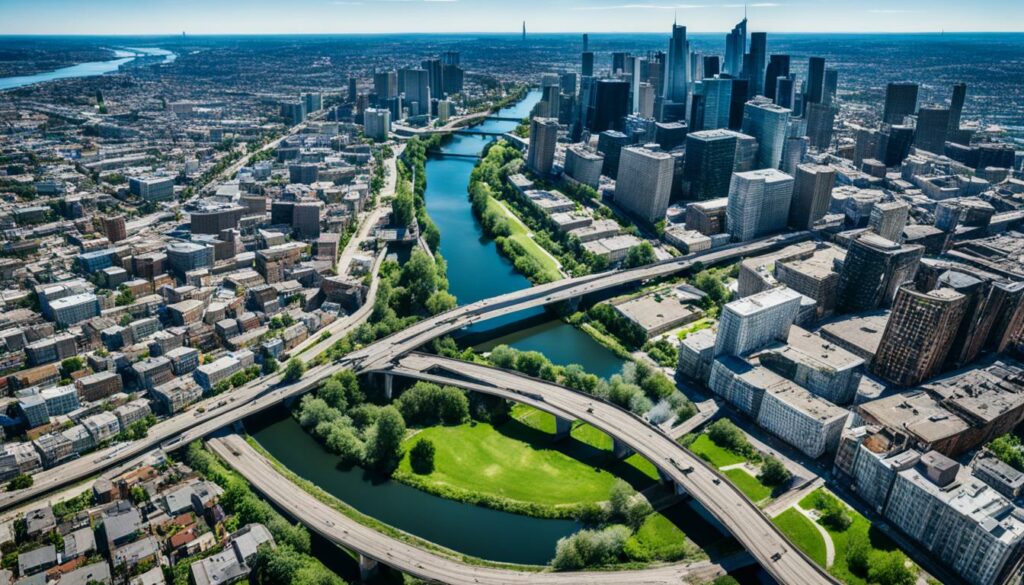
Chicago has a long history of racial segregation, with distinct neighborhoods predominantly occupied by specific racial and ethnic groups. The South Side is mostly Black neighborhoods intertwined with Mexican communities, while the North Side is more diverse with immigrant populations. The physical separation of these neighborhoods has resulted in significant political, economic, psychological, and cultural implications for the residents. Living in such a segregated city contributes to confusion, hate, and violence.
Segregation in Chicago has created a stark divide between communities, perpetuating inequalities and fostering a lack of understanding and empathy among residents. The racially divided neighborhoods have their own unique characteristics, culture, and challenges, further deepening the divisions within the city.
South Side: Black Neighborhoods and Mexican Communities
The South Side of Chicago primarily consists of predominantly Black neighborhoods, such as Englewood, Bronzeville, and Roseland. These areas have a rich cultural heritage and a vibrant African American community. However, they also face numerous challenges, including concentrated poverty, limited access to quality education and healthcare, and high crime rates.
In addition to the Black neighborhoods, the South Side is also home to Mexican communities, such as Pilsen and Little Village. These areas have a strong Mexican heritage and play an essential role in Chicago’s cultural diversity. However, they too face their own unique set of challenges, including economic disparities, language barriers, and gentrification.
North Side: A Diverse Tapestry of Immigrant Populations
Unlike the predominantly Black neighborhoods on the South Side, the North Side of Chicago is much more diverse, with a mix of immigrant populations from various countries. Neighborhoods such as Uptown, Lakeview, and Rogers Park are home to communities from different parts of the world, including Eastern Europe, Asia, Latin America, and Africa.
The North Side showcases the beauty of multiculturalism and provides opportunities for residents to experience different cultures and cuisines. However, this diversity does not eliminate the challenges faced by these communities, such as gentrification, income inequality, and limited access to affordable housing.
Living in a racially divided city like Chicago has profound consequences for its residents. The physical separation of neighborhoods based on race creates barriers to understanding and empathy, perpetuating prejudice and discrimination. It is essential to acknowledge the impact of segregation in Chicago and work towards a more inclusive and united future.
Historical Origins of Segregation in Chicago
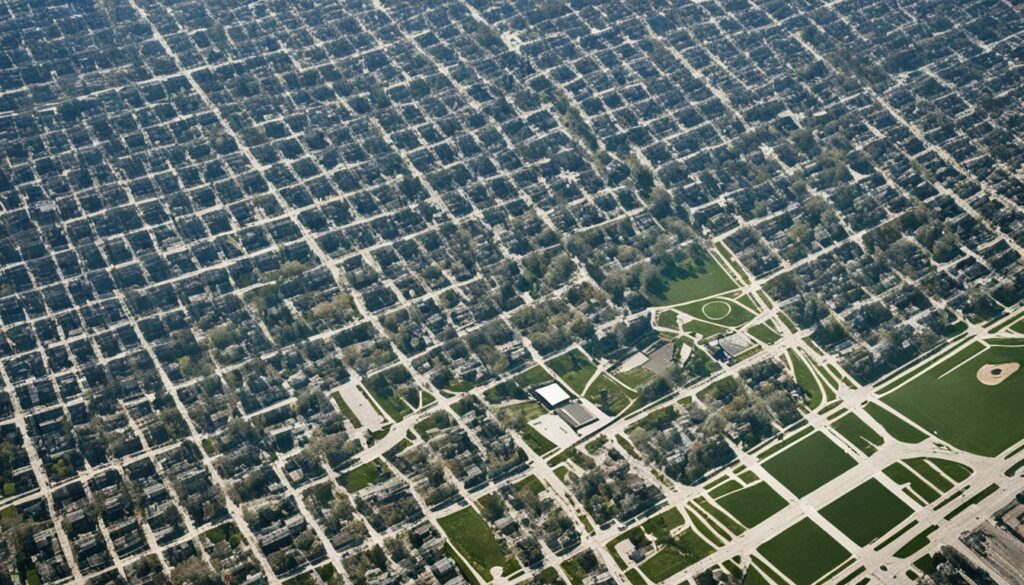
Chicago’s history of segregation can be traced back to the city’s settlement by European colonizers in the mid-1800s. As various immigrant groups flocked to the city, Chicago experienced significant population shifts, including the arrival of African Americans and Mexican immigrants during the Great Migration.
However, white Chicagoans viewed the influx of people of color as a threat, leading to the organization of the city into segregated areas. This intentional fragmentation not only preserved cultural practices but also fueled racial and ethnic tensions within the city.
“The settlement of Chicago by European colonizers and the subsequent population shifts during the Great Migration played significant roles in shaping the racial dynamics and community divisions we see in Chicago today.”
This segregation by race and ethnicity had profound implications for Chicago’s neighborhoods and communities. It created physical and psychological barriers, perpetuating inequality and deepening the racial divide in the city.
The image below illustrates the racial composition of Chicago neighborhoods, showcasing the stark contrast between predominantly white and predominantly non-white areas.
| Neighborhood | Racial Composition |
|---|---|
| North Side | Predominantly white with diverse immigrant populations |
| South Side | Mainly Black neighborhoods intertwined with Mexican communities |
This stark division not only limited opportunities for social and economic mobility but also contributed to the perpetuation of racial tensions and disparities in resources and opportunities.
The Legacy of Segregation
The legacy of historical segregation in Chicago continues to shape the city’s neighborhoods and communities. Understanding the historical origins of segregation is crucial in addressing the deep-seated issues that contribute to racial inequality and ongoing tensions within the city.
Next, we will explore the government-sanctioned segregation policies and their impact on Chicago’s neighborhoods.
Government-Sanctioned Segregation
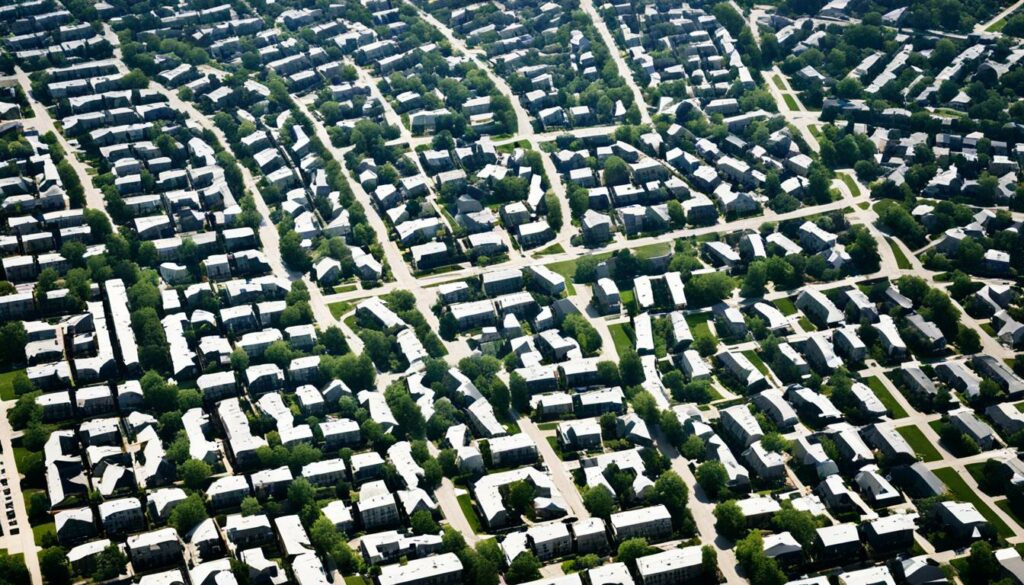
The U.S. Housing Act of 1937 had a significant impact on racial segregation in Chicago neighborhoods. This legislation provided the opportunity for the construction of public housing projects, which ultimately further perpetuated the division along racial lines.
“These projects confined communities based on race.”
Instead of promoting integration and fostering diversity, these projects enforced racial boundaries, exacerbating the existing divide. Access to resources, such as quality education, healthcare, and economic opportunities, became limited for marginalized communities.
Moreover, the consequences of government-sanctioned segregation went beyond physical separation. Public housing projects unintentionally became hubs for the proliferation of drugs and weapons, perpetuating a cycle of addiction, violence, and trauma within predominantly Black and brown neighborhoods.
The intentional flooding of these communities with drugs, like crack-cocaine during the 80s, heightened the challenges faced by residents, contributing to the perpetuation of inequality.
“The creation of segregated neighborhoods and the establishment of the Chicago Police Department as a force primarily serving white Chicagoans were the foundation of a systematic structure that perpetuated inequality and division.”
This systematic structure not only perpetuated racial and socioeconomic disparities but also created an environment where inequality flourished. The Chicago Police Department, originally established to serve and protect white Chicagoans, further enforced segregation, contributing to the deep-rooted divisions in the city.
Impact of Public Housing Projects
The negative consequences of public housing projects were far-reaching and continue to affect Chicago neighborhoods to this day. The racial segregation they enforced limited opportunities for upward mobility and hindered social and economic progress.
Systemic Disinvestment and Deprivation
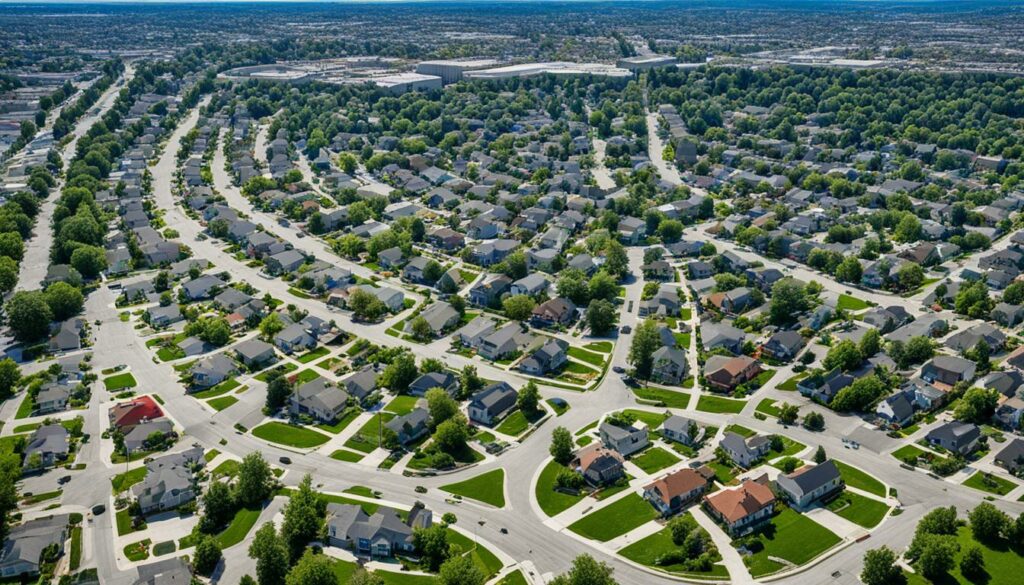
Segregated neighborhoods in Chicago often faced a severe lack of resources, leading to economic disparities and racial inequality. The intentional deprivation of economic development, mental health services, healthcare, and substance abuse treatment in these communities perpetuated cycles of poverty, addiction, and violence. The scraps of resources allocated to the segregated neighborhoods became sources of contention among the Black and Brown communities.
Residents of segregated neighborhoods in Chicago have long endured the consequences of systemic disinvestment and deprivation. The lack of resources in these communities has exacerbated economic disparities and deepened racial inequality. Essential services such as healthcare, mental health support, and substance abuse treatment are often scarce or nonexistent.
This lack of resources and support perpetuates cycles of poverty, addiction, and violence, trapping residents in a never-ending struggle. The meager resources that are allocated to these segregated neighborhoods are often inadequate, leading to constant competition and tension within the community.
“The scraps of resources allocated to the segregated neighborhoods became sources of contention among the Black and Brown communities.”
This intentional deprivation of economic development and basic resources has profound consequences. It limits opportunities for upward mobility and stifles economic growth in these communities. As a result, residents are trapped in a cycle of poverty with limited access to quality education, job opportunities, and affordable housing.
The impact of this systemic disinvestment is particularly evident in the health outcomes of residents in segregated neighborhoods. Lack of access to healthcare and mental health services leads to poorer health outcomes, higher rates of chronic illnesses, and increased mortality rates.
The Impact of Economic Disparities
Economic disparities caused by the lack of resources in segregated neighborhoods have far-reaching consequences. Limited access to capital, financial institutions, and business opportunities makes it difficult for residents to start businesses and build wealth.
Moreover, the lack of investment in education further widens the gap between segregated neighborhoods and more affluent areas. Dilapidated school buildings, outdated resources, and overcrowded classrooms hinder educational attainment and limit opportunities for academic success.
The Cycle of Poverty, Addiction, and Violence
The lack of resources in segregated neighborhoods contributes to a vicious cycle of poverty, addiction, and violence. Limited access to mental health services and substance abuse treatment exacerbates addiction and mental health issues within these communities, leading to increased crime and violence.
Without proper resources and support systems, residents are left to bear the burden of these social issues on their own. The cycle continues as community members who are unable to access the necessary resources turn to illegal activities to cope, perpetuating the cycle of poverty and violence.
| Consequences of Systemic Disinvestment | Impact on Segregated Neighborhoods |
|---|---|
| Lack of access to healthcare | Higher mortality rates, poor health outcomes |
| Limited job opportunities | High unemployment rates, lower income |
| Inadequate education resources | Lower academic achievement, limited opportunities |
| Scarce mental health services | Higher rates of mental illness, lack of support |
| Restricted access to capital | Difficulty starting businesses, limited wealth creation |
Gangs and Community Defense

Gangs have a complex history in the neighborhoods of Chicago. Originally emerging within communities of color, these groups formed as a means of self-defense against the violence and brutality inflicted by the racist police and white gangs. Their primary objective was to protect their communities and gain access to resources that had been denied to them.
However, the socio-economic challenges faced by these communities, including increasing poverty, addiction, and violence, corrupted these organizations. As a result, the very gangs that were formed to defend and uplift their neighborhoods ended up perpetuating harm within the communities they aimed to protect.
Gang violence in Chicago has had a profound impact on the city’s neighborhoods. It has contributed to a cycle of fear, destruction, and loss that has further deepened the social and economic disparities already prevalent in these areas.
“Gangs are a double-edged sword,” says community activist and Chicago resident Jane Williams. “While they were initially formed to protect their communities, the internal power struggles, drug trade, and systemic violence have turned them into a source of further harm.”
The History of Gang Violence in Chicago
Gang violence in Chicago can be traced back to the early 20th century when street gangs like the Vice Lords and the Disciples originated. These gangs initially formed as social and community-oriented organizations. However, over time, factors such as poverty, limited opportunities, and the influence of external criminal enterprises transformed them into entities focused on territorial control and illegal activities.
“The transformation of gangs from community defense organizations to criminal enterprises is a reflection of the systemic issues that plague Chicago,” explains sociologist and gang expert Dr. Michael Sanchez. “The lack of resources, educational opportunities, and safe spaces for young people have contributed to the allure of gangs as an alternative support system.”
Despite their negative impact, it is essential to understand that gangs do not represent the entirety of Chicago’s communities. There are many grassroots organizations and community leaders working tirelessly to break the cycle of violence and provide support and resources to at-risk youth.
Building Community Defenses
To address the issue of gangs and violence, community defense organizations have emerged. These organizations focus on providing alternatives to gang involvement and creating a supportive environment for youth. By offering mentorship programs, educational resources, vocational training, and community engagement initiatives, they aim to empower young individuals and guide them away from the path of violence.
One such organization is the Inner-City Youth Empowerment Network (IYEN), founded by community activist and former gang member David Rodriguez. IYEN works in collaboration with community members, schools, and local businesses to create opportunities for youth to thrive and develop positive life skills.
“Our goal is to break the cycle of violence and empower the next generation,” says Rodriguez. “By working hand-in-hand with community members and providing the necessary support, we can create a safer and more prosperous future for all.”
Through the dedicated efforts of organizations like IYEN and the collective work of community members, Chicago is taking steps towards transforming the narrative surrounding gangs and community defense. The focus now lies on creating sustainable solutions that address the root causes of gang violence and build a brighter future for Chicago’s neighborhoods.
Civil Unrest and George Floyd’s Murder
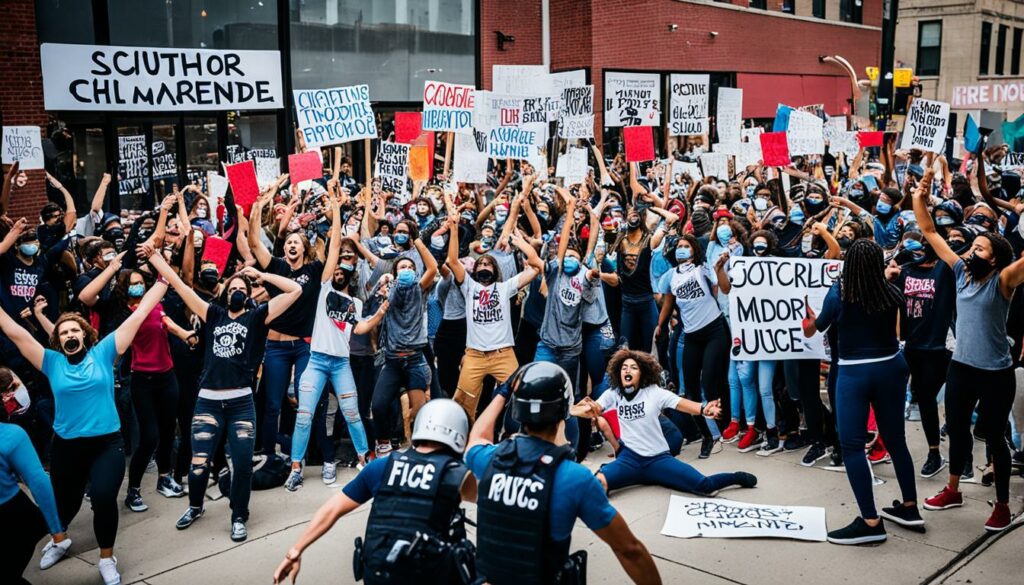
The murder of George Floyd in Minneapolis on May 25, 2020, ignited a wave of outrage and protests against police violence across the nation. Chicago, like other cities, joined in expressing its anger and demanding justice for Floyd and accountability for the involved officers.
What started as peaceful protests in Chicago soon escalated into widespread civil unrest. The demonstrations turned into riots due to instigation and antagonistic behavior from both protesters and the police. The response from the city authorities, including the implementation of curfews and containment measures, further fueled the anger and retaliation.
Protests in Chicago
Protests in Chicago were characterized by passionate calls for justice and an end to police violence. Thousands of people took to the streets, braving tear gas, rubber bullets, and arrests to voice their frustrations and demand meaningful change. The rallies spanned various neighborhoods and communities, highlighting the widespread support for justice and police reform.
“We stand together against the systemic racism that plagues our city and nation. The murder of George Floyd is a wake-up call, and we will not be silent until there is true accountability and change.” – Protester
The protests were a manifestation of the deep-rooted anger and pain caused by the long history of racial injustice and police brutality in Chicago. It served as a platform for individuals to express their grief and call for an end to the senseless violence.
Geographical Impact of Riots
The riots in Chicago extended far beyond the downtown area, spreading into predominantly Black and Brown neighborhoods on the South and West Sides. The impact of the riots was devastating, with widespread looting, destruction, and vandalism of businesses, buildings, and vehicles throughout these communities.
The absence of a significant police presence in response to the ongoing rioting and intentional containment measures only heightened the intensity of the unrest. This lack of law enforcement allowed chaos and anxiety to permeate the neighborhoods, exacerbating the already volatile situation.
“Businesses, buildings, and vehicles were looted, set on fire, and vandalized throughout these communities.”
The rioting and its aftermath left a profound impact on the affected neighborhoods, deepening existing inequalities and further threatening the socio-economic stability of the residents. The destruction caused by the riots will undoubtedly have long-lasting consequences for the individuals and businesses in these areas.
Fear and Media Portrayal
The media’s portrayal of violence in Chicago has perpetuated a sense of fear and insecurity among the public. The city has often been referred to as “Chiraq,” a term popularized by Chief Keef and other artists, which conveys an image of Chicago as a war zone.
Many parents, particularly those from privileged backgrounds, express concern about the safety of their children in certain neighborhoods. The constant exposure to news stories and headlines highlighting violence in Chicago has reinforced negative perceptions and stigmatization of the city.
“The media’s constant focus on violence in Chicago only amplifies the fear and misconception of the city. It’s important to remember that there are many wonderful communities and vibrant cultures in Chicago that go unnoticed due to this biased portrayal.” – Resident of Chicago
Some argue that the media’s depiction of Chicago as “Chiraq” glamorizes violence and perpetuates negative stereotypes, while others view it as a stark reality and an expression of survival in a harsh environment.
It is crucial to critically analyze the media’s role in shaping public perception and understanding the broader socio-economic factors that contribute to violence in Chicago. By promoting a more accurate and nuanced portrayal of the city, we can work towards breaking stereotypes and creating a safer, unified Chicago for all its residents.
Chief Keef and the Commercialization of “Chiraq”
Chief Keef, a prominent figure in the Chicago rap scene, has played a significant role in popularizing the term “Chiraq” through his music. His lyrics vividly depict the violence and struggles of life in Chicago’s neighborhoods. With his success in the commercial rap industry, Chief Keef has been able to capitalize on the gritty image associated with “Chiraq,” but this also raises questions about the commodification of his personal experiences.
Chief Keef’s music often portrays the harsh realities of surviving in a city plagued by systemic issues, including violence and inequality. While some interpret his music as a celebration of violence, it is more accurately seen as a poignant reflection on the oppressive environment in which young Black men like Chief Keef find themselves.
“I came from Chicago where gunshot became lullaby, cops become the bad guys, I’m just telling my story.”
– Chief Keef
Chief Keef’s lyrics and persona shed light on the social and economic struggles faced by many in Chicago’s marginalized communities. However, the commercialization of this image in the rap industry can perpetuate stereotypes and reinforce negative perceptions of these neighborhoods.
It is essential to recognize that Chief Keef’s music, although controversial, serves as a form of expression and a platform to shed light on the realities of violence and adversity in Chicago. By confronting these issues through his lyrics, Chief Keef challenges the status quo and offers his perspective on the complexities of life in “Chiraq.”
Impact on the Commercial Rap Industry
Chief Keef’s emergence in the commercial rap industry marked a shift in the genre’s landscape. His unfiltered portrayal of life in Chicago resonated with audiences and opened doors for other artists hailing from similar communities. This led to a wave of artists expressing the realities of their own neighborhoods through their music.
The commercial success of Chief Keef and artists inspired by him indicates a demand for authenticity and raw storytelling that delves into the depths of the human experience. However, the commercialization of this image also raises concerns about the exploitation of trauma and reinforces harmful stereotypes in the pursuit of profit.
The Controversy Surrounding Violent Lyrics
Chief Keef’s music often features lyrics that depict violence, reflecting the harsh realities of his surroundings. While some argue that this perpetuates a cycle of glorifying violence, others see it as a raw depiction of the environment in which Chief Keef and many others grew up.
It is important to contextualize Chief Keef’s lyrics within the larger rap landscape, recognizing that violence has been a recurring theme in the genre for decades. Through his music, Chief Keef provides a voice for those who have felt unheard and marginalized, shedding light on the root causes of violence in certain communities.
The Role of Chief Keef in Shaping Public Perception
Chief Keef’s popularity and influence have made an impact beyond the music industry. His image and lyrics have contributed to the perception of Chicago as “Chiraq,” a city plagued by violence and chaos. This portrayal, perpetuated through media coverage and popular culture, has both positive and negative consequences.
On one hand, it brings attention to the issues faced by marginalized communities and sparks conversations about systemic inequalities. On the other hand, it can reinforce stereotypes and overshadow the resilience, creativity, and positive aspects of these neighborhoods.
The Intersection of Art and Reality
Chief Keef’s music serves as a reflection of his lived experiences and the environment in which he grew up. By expressing his reality through his art, Chief Keef challenges societal norms and brings attention to the systemic issues that contribute to the violence and adversity in Chicago’s neighborhoods.
Ultimately, Chief Keef’s music and his impact on the commercial rap industry provide a platform for dialogue and examination of the complex issues surrounding violence, inequality, and the commodification of personal experiences.
| Pros | Cons |
|---|---|
|
|
Conclusion
The recent riots involving Chicago teens are a manifestation of deeply rooted systemic issues that have plagued the city for decades. These riots serve as a stark reminder of the historical segregation, economic disparities, and racial inequality that continue to define Chicago. Analyzing the causes and impacts of these teen riots is crucial in order to address the underlying problems and work towards lasting solutions.
The riots are a direct result of the historical segregation that has divided Chicago along racial lines. The city’s segregated neighborhoods have created a sense of isolation and frustration among its residents, particularly the youth who feel marginalized and unheard. The lack of resources and opportunities in these areas further perpetuates the cycle of poverty and violence, leading to a sense of hopelessness and despair.
In order to address the impacts of these teen riots, it is essential for Chicago to confront its history and acknowledge the role that systemic racism and inequality have played in perpetuating these issues. This requires a comprehensive approach that addresses not only the immediate causes of the riots, but also the underlying social, economic, and political factors that contribute to the unrest.
By investing in education, job opportunities, affordable housing, and community-based programs, Chicago can begin to repair the damage caused by decades of neglect and disinvestment. Additionally, fostering open and honest dialogue between community members, law enforcement, and government officials is crucial in building trust and creating a more just and inclusive city for all its residents.
FAQ
Why are teens rioting in Chicago?
The recent riots in Chicago involving teenagers have been fueled by deep-seated systemic issues, including historical segregation, economic disparities, and racial inequality. Understanding these root causes is crucial in addressing the underlying problems and finding sustainable solutions.
What are the causes of teen riots in Chicago?
The causes of teen riots in Chicago are multifaceted and include factors such as historical segregation, limited access to resources in segregated neighborhoods, gang violence, and the response to incidents of police violence, such as the murder of George Floyd.
Why is Chicago a racially divided city?
Chicago’s long history of racial segregation has resulted in distinct neighborhoods predominantly occupied by specific racial and ethnic groups. The physical separation of these neighborhoods, along with systemic inequalities, has perpetuated racial divisions within the city.
How did segregation in Chicago originate?
Segregation in Chicago originated from European colonization in the mid-1800s, followed by significant population shifts due to the Great Migration. White Chicagoans organized the city to segregate communities of color, leading to the fragmentation and racial tensions that exist today.
What role did public housing projects play in perpetuating segregation?
Public housing projects, established through the U.S. Housing Act of 1937, further perpetuated racial segregation in Chicago. These projects confined communities based on race, limited access to resources, and promoted the proliferation of drugs and weapons within the neighborhoods.
How did deprivation of resources contribute to the unrest in Chicago?
Segregated neighborhoods in Chicago often face a severe lack of resources, such as economic development, mental health services, healthcare, and substance abuse treatment. This deprivation perpetuates cycles of poverty, addiction, and violence, leading to frustration and unrest among the affected communities.
What is the role of gangs in Chicago’s unrest?
Gangs emerged within communities of color in Chicago as a means of self-defense against the violence and brutality of the racist police and white gangs. While some initially sought to protect their communities, increasing poverty, addiction, and violence have corrupted these organizations, leading to further harm within the neighborhoods.
What sparked the recent riots in Chicago?
The murder of George Floyd in Minneapolis on May 25, 2020, sparked nationwide protests against police violence. Chicago joined in expressing rage and demanding justice. However, the protests in Chicago escalated into riots due to instigation and police antagonism, leading to widespread unrest.
How did the riots in Chicago impact different neighborhoods?
The riots in Chicago spread beyond the downtown area, affecting predominantly Black and Brown neighborhoods on the South and West Sides. Businesses, buildings, and vehicles were looted, set on fire, and vandalized throughout these communities, causing chaos and anxiety.
How does media portrayal contribute to fear and insecurity in Chicago?
The media’s portrayal of violence in Chicago, often referring to the city as “Chiraq,” has created a sense of fear and insecurity. This perception, fueled by sensationalized news coverage, can perpetuate negative stereotypes and stigmatize certain neighborhoods, exacerbating existing divisions within the city.
What is the commercialization of “Chiraq” and its impact?
Chief Keef, a prominent figure in the Chicago rap scene, popularized the term “Chiraq” in his music, which depicts violence and life in Chicago’s neighborhoods. Some argue that this commercialization glamorizes violence, while others see it as a grim reflection of survival in a challenging environment.
What are the impacts of the teen riots in Chicago?
The recent teen riots in Chicago have brought attention to underlying issues and prompted discussions on the city’s history of segregation, racial tensions, and systemic problems. By analyzing these events, we can gain a deeper understanding of the factors contributing to the unrest and work towards creating a more just and inclusive city for all residents.







